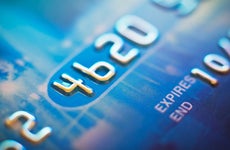Signing up for this credit card has earned me $814 and counting

The Bankrate promise
At Bankrate we strive to help you make smarter financial decisions. While we adhere to strict , this post may contain references to products from our partners. Here's an explanation for . The content on this page is accurate as of the posting date; however, some of the offers mentioned may have expired. Terms apply to the offers listed on this page. Any opinions, analyses, reviews or recommendations expressed in this article are those of the author’s alone, and have not been reviewed, approved or otherwise endorsed by any card issuer.
In late February, after praising no-annual-fee 2 percent cash back cards for years, I finally added one to my wallet. And I’m glad I did. In my first seven months with the Wells Fargo Active Cash® Card, I earned $814 in rewards ($614 as a rebate on my spending and $200 from the welcome bonus). Had I put all of that spending on one of my other credit cards, I would have earned just $307.
I always knew there were some holes in my credit card rewards strategy, but signing up for this card has worked out even better than I expected. I’m glad I finally got off the fence. I like my other two credit cards, however, both only maximize certain categories.
Filling the gaps
For example, the Blue Cash Preferred® Card from American Express is an outstanding grocery rewards card, since it gives 6 percent cash back at U.S. supermarkets (up to $6,000 in annual purchases, then 1 percent back after that). It also gives 6 percent cash back on select streaming services and 3 percent cash back at U.S. gas stations and on eligible public transit expenses.
And I really like the 5 percent rotating categories on the Chase Freedom Flex℠* (activation required, up to $1,500 in quarterly purchases, 1 percent cash back after that). The Freedom Flex is also my go-to card at restaurants (3 percent cash back).
Each card has additional benefits, too, but the problem is that most purchase categories only earn 1 percent cash back on both cards. And at scale, the difference between 1 percent and 2 percent really adds up.
In my case, over the past seven months, I’ve spent almost $31,000 in these “everything else” categories that would have previously earned me only 1 percent back. Examples include summer camps for my daughters, home repairs, groceries beyond the Blue Cash Preferred’s $6,000 annual limit, travel costs and more.
Mass appeal
A no-annual-fee 2 percent cash back card isn’t necessarily the best card for everyone, but I’ll argue that it’s probably the best choice for the widest range of credit cardholders. That’s assuming you can pay your bills in full to avoid interest, of course. If you’re among those who carry a balance (47 percent of cardholders, according to a recent Bankrate survey), then it’s best to focus on your debt payoff strategy rather than chasing credit card rewards. In other words, don’t pay 20 percent or more in interest (the national average is currently over 20 percent) just to earn 1 or 2 or even 5 or 6 percent cash back.
In terms of cash back versus travel rewards, our research shows that cash back is favored by most Americans. That’s because it’s so simple and universal. Who couldn’t use more cash, right? Most people don’t want to put a lot of work into their credit card strategy, either. They’d rather use just one or two cards as widely as possible.
While I know people who have dozens of credit cards and use them effectively, this is the exception, not the rule. The same goes for travel. Free flights and hotel stays are often more valuable than cash back redemptions, but it takes more effort to maximize these points and miles. Plus, travel rewards are most impactful when you have the flexibility to travel on the dates with the best promotions.
I have two young kids and a full-time job, and while I travel some, it’s not a passion of mine. Cash back rewards programs are much better suited for my lifestyle. I suspect that’s true for most of you, which is why no-annual-fee 2 percent cash back cards are so broadly applicable. You could do quite well by using one of these as your primary credit card, and you can do even better if you use one as a foundation and layer in another card or two or three that lean into specific categories in which you spend a lot of money.
Building credit
Besides the hundreds of dollars in extra rewards that I’ve earned from using my Active Cash card, this card has also been an important tool to improve my wife Chelsea’s credit score. She’s actually the primary account holder, and I’m an authorized user (whereas I’m the primary account holder on our other two credit cards).
Having an account in her name has helped Chelsea boost her credit score from 719 (good but not great) to 840 (excellent) in short order. In fact, just one month after signing up, her score jumped from 719 to 826. I believe it’s important for each spouse to have credit in their own name, and this was something that Chelsea and I had neglected in recent years.
The bottom line
It’s important to revisit your credit card strategy at least once or twice every year. Your lifestyle changes and so does the market. Unfortunately, 43 percent of credit cardholders have either never switched their primary credit card (30 percent), or it has been at least a decade since they have switched (13 percent).
If you’ve been using the same credit card(s) for a long time, consider whether or not this is still an optimal approach. Doubling the rewards I’m earning on many of my purchases makes me glad I finally decided to follow my own advice and sign up for a no-annual-fee 2 percent cash back card.
Have a question about credit cards? E-mail me at ted.rossman@bankrate.com and I’d be happy to help.
*The information about the Chase Freedom Flex℠ has been collected independently by Bankrate.com. The card details have not been reviewed or approved by the card issuer.
Related Articles


How I earned $1,701 in credit card rewards in 2022 and what I’m planning for 2023

